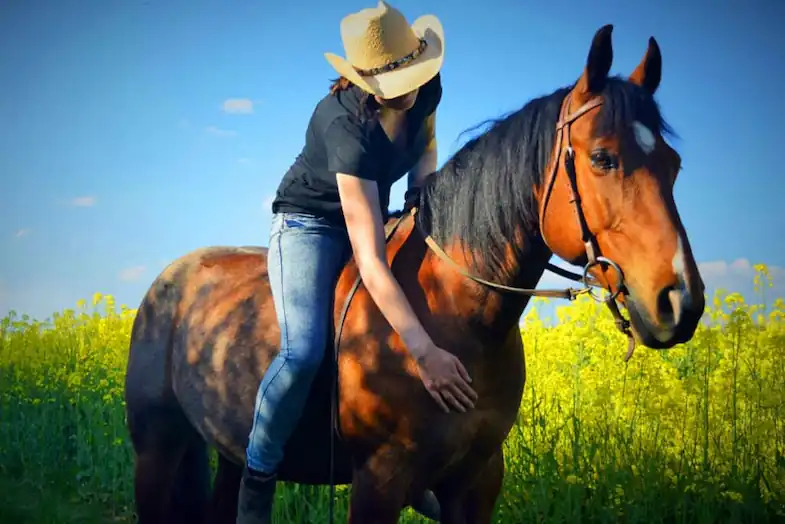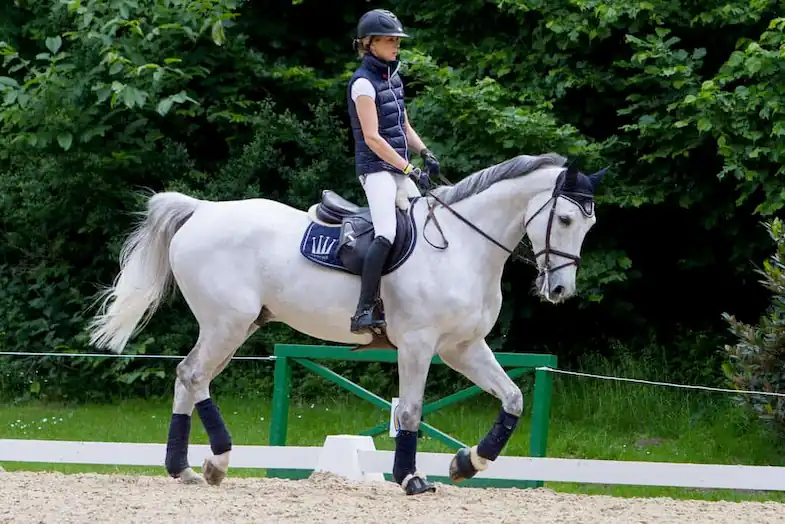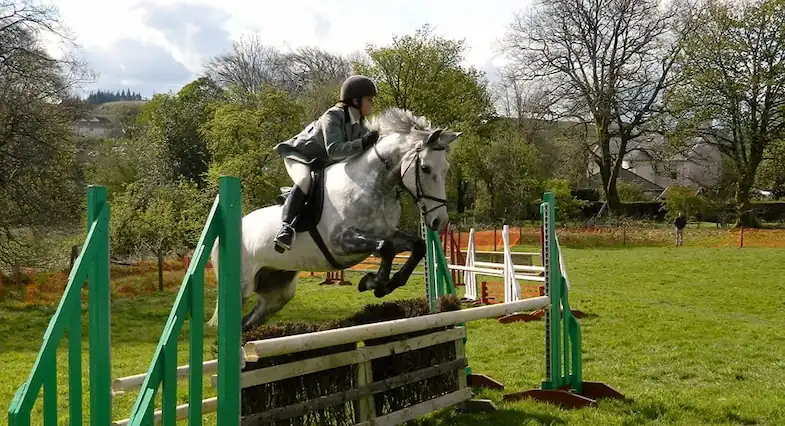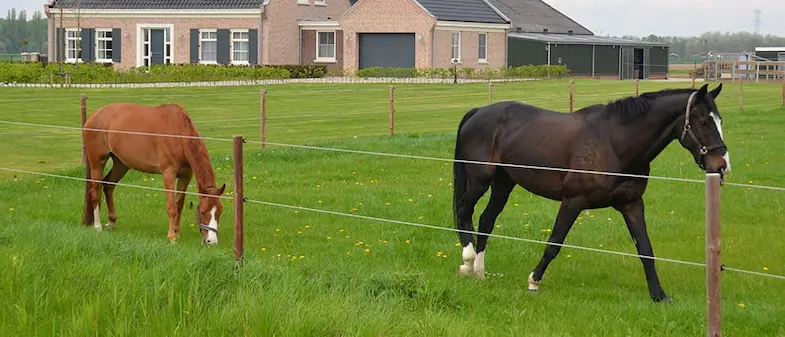Riding regularly will not only help to keep you fit but will also keep your horse fit and healthy, but how often is too often? Is it even possible to ride your horse too much? After asking other owners how frequently they ride every week I realized that we all have different riding routines which started me thinking about what is best for our horses.
To maintain fitness levels, the average horse should be ridden for at least 30 minutes 3 or more times a week. That does, however, depend on the type of riding you do, pleasure riding at a slower pace is fine every day but barrel racing puts more strain on a horse so shouldn’t be done as often.
Just like us no two horses are the same and what is right for one horse may be completely wrong for another. That said though, there are general guidelines that we can (and should) follow in order to determine how often we should be riding.
How often should I ride my horse?
You might not realize it but, while your horse’s fitness is the most important deciding factor in how often you should (and can) ride, your goals will also play a part in this. After all top-level competition horses should be ridden most days to keep them fit for competition while a family horse that’s used solely for pleasure won’t have the same level of fitness shouldn’t be ridden strenuously as often.
If your goal is competition then, of course, you should be riding more often and more vigorously. However, if your goal is to keep your horse healthy and to maintain his fitness you should ride him at least three times a week for 30 minutes to an hour each time. Instead of doing a lot of strenuous exercises though you should be including a fair amount of trotting to help develop his muscles and at least five minutes of cantering to help maintain his cardiovascular health. The table below gives you a very basic idea of how often you should ride (depending on a few basic goals) to maintain your horse’s fitness.
| Riding Goals | How Often | Type of Riding |
| Pleasure/Recreation | 20-30 minutes at least 3 times a week | Extended periods of trotting and cantering |
| Local competition | At least 4 times a week | 2 non-consecutive days intensive and 2 non-consecutive days light |
| Top-level competition | 6 times a week | Intensive training with a rest day |
As well as your horse’s fitness levels and your competition goals there are a number of other deciding factors that will determine how often you should be riding as well as how much you should work your horse when riding.
- Age – Younger horses generally have far more energy than older horses so can be ridden (or exercised) at least 3 times a week but because they don’t have the same level of fitness as older horses they shouldn’t be worked as intensely. Senior horses on the other hand shouldn’t be ridden more than 3 times a week and even that should be light and gentle.
- Fitness – If your horse has trouble recovering after a strenuous ride it’s a sign that they’re getting tired so you should reduce how often (and how hard) you ride them. Conversely though, if your horse isn’t showing any signs of tiring you can ride more often or for longer.
- Temperament – While you might not think that temperament plays a role it can make more of a difference than you realize. After all, a horse that is energetic and full of beans will enjoy being ridden more whereas less excitable horses will appreciate a break more often.
- Whether or not your horse is stabled – Horses that are stabled for long periods of time won’t have a chance to stretch their legs and exercise as much as horses that are turned out for most of the day. If your horse is predominantly stabled then you should be riding him at least three times a week, just to maintain his health.
- Your level of fitness – It might sound silly but your fitness level will also play a part in how often you should ride. If you’re out of shape not only will you find it harder to ride for long periods of time but your horse will have to work twice as hard to compensate for your lack of fitness.
How long should I ride my horse for?
Horses are more than happy covering a great deal of ground in any one day (they can cover around 32 miles in a single day) but that’s mainly done at a slow-paced walk (typically around 3mph). If you’re happy to travel like that for around eight hours then there’s no reason at all why you couldn’t do that (providing you stop regularly to give your horse a break and to allow him to drink and graze) but most people just aren’t able to do that, I know I wouldn’t even want to!
While we now know how long (and how far) horses can travel for in a day it doesn’t really answer how long we should be riding for. Regardless of how long you’re going to ride for it’s important that you warm up before and warm down after but thankfully that doesn’t need to eat into how long we ride for.
Horses that have been trained, and have higher levels of fitness, can be ridden for longer but the table below will give you a rough idea of how long you should ride your horse for, depending on what you’re doing, of course.
| Schooling or flatwork | Up to an hour |
| Trail riding | Up to 2 hours |
| Jumping or pole work | Between 20 and 40 minutes |
Can I ride my horse every day?
Looking at a field of horses grazing can give the impression they’re lazy or docile animals that don’t move much but this couldn’t be further from the truth. Horses can quite easily cover many miles every day just wondering about the field which is why, depending on how you ride, you can ride your horse every day (or even twice a day) if you’re able to.
If you do plan to ride your horse every day it’s crucial you give him time to recover properly and that you don’t exercise him strenuously every day. Unless your horse is a top-level competition horse (with the fitness levels to match) at least three non-consecutive days should be easy going and consist of mainly walking and trotting. You should also try and vary your rides too so that you’re not always doing the same thing and working your horse the same amount.
Another determining factor (and probably the most important one) in whether or not you can ride your horse every day is how fit he is and how quickly he recovers from intense exercise. After a strenuous workout watch how long it takes your horse’s heart rate and breathing to return to normal. A healthy horse will typically take up to ten minutes to recover while a horse that’s out of shape can take up to 20 minutes (anything longer and you should speak to your veterinarian as there may be an underlying issue).
If you’re in any doubt as to whether you should be riding or not don’t, it’s just not worth jeopardizing your horse’s health and fitness over.
How often should I jump my horse?
Most people will say that you should only be jumping your horse once a week during the show season, this can however increase to twice a week outside of the season. It’s also worth keeping in mind that you shouldn’t be jumping more than ten jumps at any one time either. This is, of course, for the average horse, horses that have appropriate fitness levels and are in a proper training regimen can be jumped more often and over more jumps.
Jumping is one of those disciplines where your horse’s fitness levels aren’t the only deciding factor in how often they can do it, their build will also play a role. For example, a lighter breed such as the Arabian may be able to jump without any issues but their legs aren’t designed to constantly deal with that sort of impact, whereas the Irish Draught has far stronger legs so is capable of jumping more often.
How often should I ride my horse in the winter?
It can be harder to motivate yourself to ride when the weather gets colder and the days get shorter (and darker) but there’s no real reason why you should reduce or change your riding routine during the winter. If anything riding can be extremely beneficial because it can help to warm your horse up.
The one thing that you should increase during the winter though is how much time you spend warming up before riding and then warming down again after. When your horse is colder he’s far more likely to pull muscles or damage his joints which is why this is even more important during the winter, as a bonus it’ll also help you to warm up! With this in mind, it’s a good idea to warm your horse up for around 10 to 20 minutes during the winter (and of course the same amount of time after a ride too).
You don’t have to walk your horse in endless circles to warm him up though, you can incorporate a bit of slow trotting as well as some pole work too. The main thing is that you’re getting your horse’s blood flowing while also loosening up his stiff muscles and joints.
How long can a horse go without being ridden?
You might think that you need to ride your horse at least once a week but this isn’t always the case, as long as your horse is getting some exercise there’s nothing to say you have to ride him at all. If your horse is stabled for most of the time then you’ll need to ride (or lunge) him a few times a week just to keep him in good health.
Horses that are turned out for long periods of time will spend a lot of this time wondering about their field and while this is very rarely strenuous exercise it is enough to keep your horse healthy if you’re not able to ride.
How do you know if your horse is okay with his workload?
No two horses are the same and what works well for one horse won’t necessarily be good for another which is why you should keep a close eye on your horse’s health, fitness, and recovery times. Keeping a record of every time you ride (along with how your horse recovers) can really help you have a good understanding of how fit your horse is as well as whether or not he’s improving. You should record how you ride in terms of for how long, what you did, and even what the weather was like as well as how it affected your horse. Then, over time, you’ll have a good understanding of your horse’s fitness. While there are many different ways of recording your ride, I’ve created a complete printable horse record kit that you can download for free. This will help to keep all of your horse’s important information (not just your rides) in one place.
The most important thing though is to put your horse first and never ride when he’s tired. Doing so will not only impact on his fitness but could also have a negative effect on his confidence.
I hope you found this article helpful. If you did I’d be grateful if you could share it please as it would really help me.
Recommended products
Over the years I have tried hundreds of different horsey products, from various blankets and halters to different treats. Some I’ve loved, others I’ve hated but I thought I’d share with you my top all-time favorite products, the ones I never leave the yard without. I’ve included links to the products (which are in no particular order) that I really think are great.
- Horse Knots by Reference Ready – If you’re like me and enjoy pocket reference guides then you’ll love this knot tying guide. These handy cards can easily fit in your pocket or attach to the saddle for quick reference. They’re waterproof, durable and are color coded to make them easy to follow.
- Mane ’n Tail Detangler – Even if you never show your horse you’ll need to detangle his tail from time to time (and possibly his mane too) which is always a challenging chore! I’ve found that if I run a little bit of detangler through my horse’s tails every few days it stops them from getting matted up and makes combing them easy, even if they’re coated in mud. I don’t know if I should admit to this or not but it also works wonders on my hair.
- TAKEKIT Pro clippers – Over the years I’ve tried a lot of different clippers and while some were obviously better than others I found these to be by far the best. They are heavier than a lot of other clippers but for me, that’s a good thing, it makes them feel more sturdy and hardwearing. On top of that they have a range of speeds so are just as good for clipping your horse’s back as they are his face. I also like the fact that they come in a handy carry case but that’s not for everybody. The company that makes them is super good and incredibly helpful too, a real bonus these days. The only thing I wasn’t keen on was the fact that it doesn’t come with any oil, but that’s not a major problem as it’s not difficult to buy lubricant.
- Shire’s ball feeder – There are so many boredom buster toys out there but I like to use these every day, regardless of whether or not my horses are bored. I find that it helps to encourage my horses to problem solve by rewarding them with treats (or pieces of fruit) but it also mimics their natural grazing behavior which helps to keep them calm and de-stressed.
- Horse safe mirror – This is a strange one that many people are surprised about but I like to put horse safe mirrors in the trailers as well as in the quarantine stalls. It helps to prevent the feeling of isolation by giving the impression of other horses being around. Being herd animals horses can get extremely stressed when they feel that they’re on their own but with these stick-on mirrors, they believe that at least one other horse is with them.
- Rectal thermometer – I know this isn’t glamourous at all but it’s vital for your horse’s well-being to be able to check their temperature and a rectal thermometer is the easiest way of doing this which is why I’ve added it to the list.
Shopping lists
I’ve also put together a few shopping lists of essential items that I’ve found helpful over the years. I’ve broken the lists down into different categories rather than put everything in one massive list 😉





